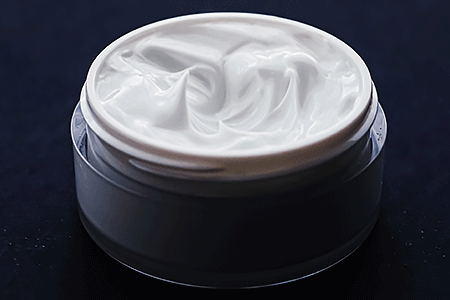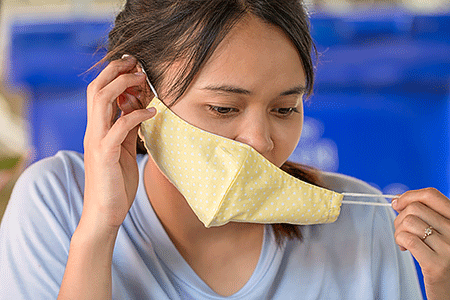10 ways to prevent face mask skin problems
Wearing a mask can be hard on your skin
Gentle skin care can prevent your mask from causing skin problems.

Wearing a face mask lowers your exposure to viruses like COVID-19, flu, and respiratory syncytial virus (RSV), which spread when people cough, sneeze, or talk. Masks can also be hard on your skin, causing problems that range from acne and peeling skin to rashes and itchiness.
To help prevent skin problems from developing under your mask, board-certified dermatologists recommend these 10 tips.
Cleanse and moisturize your face daily. Gentle skin care can prevent skin problems. When washing your face, use a mild, fragrance-free cleanser and follow the steps in Face washing 101.
Protect your lips by applying petroleum jelly. Wearing a face mask can dry your lips, leading tochapped lips. You can prevent chapped lips by applying petroleum jelly to your lips:
- Before you put on your mask
Skip the makeup when wearing a mask. Beneath a mask, makeup is more likely to clog your pores and lead to breakouts. If makeup is necessary, only use products labeled “non-comedogenic” or “won't clog pores.”
Avoid trying new skin care products that can irritate your skin. Wearing a mask for even a short time can make your skin more sensitive. To reduce skin problems, avoid trying harsh products, such as a chemical peel, exfoliant, or retinoid, for the first time, says board-certified dermatologist Daniela Kroshinsky, MD, MPH, FAAD.
Retinoids can irritate your skin
“If you’ve been using a retinoid (or retinol), apply it at bedtime and don’t increase the amount that you apply.”
Tip courtesy of board-certified dermatologist Daniela Kroshinsky, MD, MPH, FAAD

Use less of certain skin care products if your face becomes irritated. When you cover your face with a mask, some skin care products that you’ve used in the past may irritate your skin. If this happens, Dr. Kroshinsky recommends cutting back on products that can irritate your skin, such as:
Wear a mask that fits properly. To reduce skin problems, look for masks that offer the following:
If the mask feels too tight or slides around on your face, it can irritate your skin. You’re also more likely to adjust a poorly fitting mask. When you touch your mask, you can transfer germs from your hands to your mask and face.Take a 15-minute mask break every 4 hours. Health care workers have found that this helps save their skin.
Stop behind-the-ear soreness
Find masks with different types of ties and ear loops and wear a different type each day.
Tip courtesy of board-certified dermatologist Daniela Kroshinsky, MD, MPH, FAAD

Wash a cloth mask and throw away a surgical (disposable) mask after wearing it once. Many health care organizations recommend that you throw away a surgical (disposable) mask and wash a cloth. This helps reduce your risk of getting sick.
Throwing away or washing your mask also helps protect your skin. Makeup, oil, and other particles can build up on the mask. If you wear the mask a second time, it can irritate your skin and lead to skin problems.
You can wash a cloth mask in a washing machine or by hand. Both ways remove oil, makeup, and other particles. Just be sure to:Stop wearing a wet or dirty mask or respirator. When a mask or respirator becomes wet or dirty, it loses its ability to protect you. Using a wet or dirty mask can also irritate your skin, leading to skin problems.
If your surgical (disposable) mask, N95 respirator, or KN95 respirator becomes wet or dirty, immediately replace it with a clean one and throw away the wet or dirty one.
If your cloth mask becomes wet or dirty, put on a clean mask. To prevent your cloth mask form getting moldy, the CDC recommends that you “put it in a sealed plastic bag until you can wash it.”Continue treating a skin condition. If you have a skin condition that affects the skin covered by a mask, such as acne or rosacea, it’s especially important to follow the treatment plan that your dermatologist created for you. This can help keep the condition under control.
If you notice that your skin becomes irritated or the condition worsens while wearing a mask, tell your dermatologist.
By using a moisturizer formulated for your skin type, you can prevent breakouts. When selecting moisturizer, follow this guide:
Normal or combination skin: Lotion
Dry to very dry skin: Cream
If you have acne or tend to break out, you can still use a gel moisturizer.
Apply moisturizer before and after wearing a mask
Moisturizer can prevent problems, especially if you have dry or sensitive skin.
Tip courtesy of board-certified dermatologist Carrie L. Kovarik, MD, FAAD

To prevent breakouts, take care to apply the petroleum jelly only to your lips.
.
Wearing a mask that offers a snug but comfortable fit and at least two layers also helps to protect you from respiratory viruses.
How to choose the right face mask for your skin
Choosing the right face mask can help prevent skin problems. Board-certified dermatologists recommend looking for these things when choosing a face mask.
If you use an N95 or KN95 respirator, the CDC recommends that you “check the manufacturer’s instructions to learn how long they can be worn before they should be thrown away.” You also want to replace a respirator when the straps are stretched out and the respirator no longer fits snugly against your face.
If you develop a face mask skin problem
Life gets busy. Sometimes, it’s hard to care for your skin as planned. If a skin problem develops under your mask, you may be able to treat it yourself. See what dermatologists recommend at, Face mask skin problems: DIY treatment.
Images
Reference
Centers for Disease Control and Prevention (CDC).
How to use your N95 respirator.” Page last updated 5/16/2023. Page last accessed 2/5/2024.
“Use and care of masks.” Page last updated 5/11/2023. Page last accessed 2/5/2024.
Written by:
Paula Ludmann, MS
Reviewed by:
Carrie L. Kovarik, MD, FAAD
Natalie Matthews, MD, FAAD
Sanna Ronkainen, MD, FAAD
Last updated: 8/7/24
 Atopic dermatitis: More FDA-approved treatments
Atopic dermatitis: More FDA-approved treatments
 Biosimilars: 14 FAQs
Biosimilars: 14 FAQs
 How to trim your nails
How to trim your nails
 Relieve uncontrollably itchy skin
Relieve uncontrollably itchy skin
 Fade dark spots
Fade dark spots
 Untreatable razor bumps or acne?
Untreatable razor bumps or acne?
 Tattoo removal
Tattoo removal
 Scar treatment
Scar treatment
 Free materials to help raise skin cancer awareness
Free materials to help raise skin cancer awareness
 Dermatologist-approved lesson plans, activities you can use
Dermatologist-approved lesson plans, activities you can use
 Find a Dermatologist
Find a Dermatologist
 What is a dermatologist?
What is a dermatologist?

